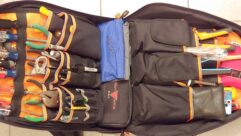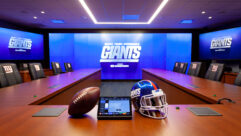A SUCCESSOR TO MY TRUSTY VTG-200?
GET WHAT YOU NEED
The ongoing transition to digital television has been anything but smooth. There was a big debate, now settled, about which modulation standard to use. Then there were waves of indoor and outdoor signal reception tests, modification and upgrades to set-top receivers, and problems with component signal format compatibility (particularly with the non-standard 540p RGBHV connection adopted by RCA).
Now, we’ve got another problem: how to set up and calibrate HD-capable monitors and projectors. The component signal standards for 1080i (SMPTE 274M) and 720p (SMPTE 296M) are not the same as those used for NTSC and component 480i video. For starters, the color space used in both HD formats is slightly larger. Instead of a bilevel sync format, a trilevel sync pulse is called for.
Until recently, there has been a dearth of affordable HDTV test-pattern generators on the market, but that’s changed in the past year. Two companies — Sencore and AccuPel — have brought out full-featured test-pattern generators suitable for calibration of HD displays. I had the opportunity to check them out recently while looking for an alternative to my trusty old Extron VTG-200 test-pattern generator, which I acquired in 1995. The VTG-200 is quite good for setting up RGB displays and even has an NTSC composite output. However, it is limited to one HD output rate (1920 by 1035i) and only in RGBHV mode. The VTG-200 also was constrained by its selection of test patterns; it doesn’t include a PLUGE for setting grayscale and black levels.
▪ Sencore VP300. Sencore’s VP300 VideoPro multimedia video generator (as it is formally known) represents a better alternative. First of all, it supports a wide range of ATSC and nonstandard HD formats, including 720p, 960p (line quadrupling), 1080i, 1080p and JVC’s 1365-by-768 D-ILA standard (also useful for setting up 50-inch plasma panels). Numerous picture refresh rates are available, including 59.94 and 60 Hz, and the 24-frame rate used for electronic cinema production.
The VP300 also supports several SDTV rates, such as 480i at 29.97 Hz, 480i/30, 480i/59.94 and 480p/60. Thirty-eight VESA RGB rates for calibrating PC displays are thrown in for good measure, and of course, there are composite connections for NTSC and PAL set up. Test patterns include PLUGE, window patterns, SMPTE color bars with PLUGE, needle-pulse patterns, vertical and horizontal grayscales, ANSI and checkerboard, to name a few.
All of that is jammed into a handheld device that can run for as long as eight hours on rechargeable nickel metal hydride (NiMH) batteries, or from an external transformer. The output connections are BNC composite, S-video and 15-pin D-sub, which does double duty for RGBHV or YPbPr/YCbCr connections. The VP300 uses a menu structure similar to the VTG-200 with a backlit LCD and buttons along each side to select patterns, sync timing and component video formats. It can even calibrate and learn data. Additional buttons are used to sequence menus.
The three main menus are Signal Type (choose video, HD or VESA/Macintosh signal format), Format (select the output resolution and refresh rate from 480i/29.97 Hz video to 1080p/60, and 640-by-480 to 1920-by-1440 RGB, plus a few plasma rates), and Pattern (choose the pattern you need to perform a calibration or test). Navigating to a specific pattern on the VP300 is simply a matter of going through these three steps (or just selecting different patterns once you’ve chosen a video/RGB format). But there’s additional functionality behind these menus, as well.
There is gating, for example, which allows the user to shut off individual red, green and blue channels during a test (such as color saturation and hue in NTSC). A user can also select sync polarity and sync type in this menu. The color gating function works on all composite, S-video and RGB outputs (except ramp). It’s not available when testing YPbPr patterns.
The Test function almost works like a macro file. You can have the VP300 automatically sequence through a series of patterns by selecting Burn-In, or you can define your own set of patterns in the order you want them to appear and activate this set with the Sequence button. (Note: As of this writing, the custom pattern grouping feature was not active, but software to communicate with a PC and define sequences is coming shortly.)
The list of features is completed with a frequency shift sub-menu, an internal 1kHz tone oscillator for left and right stereo audio and a Learn Formats menu, which can communicate with a VESA DDC-compliant display monitor. If you have a ColorPro probe head, you can get it to communicate with the VP300 through the serial interface port while you are generating test patterns and performing measurements.
▪ AccuPel HDG-2000. AccuPel’s approach is a bit different. Its HDG-2000 HDTV component video calibration generator is not quite a full-function display calibrator, but it does do some things exceptionally well: It generates a wide range of test patterns at 1920-by-1080i and 1280-by-720p resolutions, both at 59.94 Hz (with a 60Hz special order available). The HDG-2000 is more of a chassis design that sits on rubber feet. Although very compact, it is loaded with control options. You can select four sync modes (YPbPr, RGBHV, YPbPrs and RGBHVs); toggle between 720p and 1080i output; select trilevel, bilevel or no sync; change sync polarity; and choose from 48 test patterns. Patterns include numerous variations on PLUGE, a range of 75 percent color bars and color screens, a range of 100 percent color bars and screens, eight grayscale windows and ramps, gray fields at different intensities and a set of special patterns including a 16-by-9 crosshatch, dual-needle pulse, multiburst (useful for checking signal bandwidth) and checkerboard for measuring contrast.
The S options for YPbPr and RGBHV output mimic the signal levels from third-party video scalers with 7.5 IRE black-level setup. There’s even a special mode to emulate RCA’s popular DTC-100 set-top receiver. Setting the HDG-2000 to this position outputs a 766mV RGB signal with component sync, and you can also select a YPbPr output to emulate after-market component video format converters such as Audio Authority’s 9A60.
On the rear panel, AccuPel provides a row of 5xBNC jacks (75W type) for the primary connection to the display under test. This applies in either sync-on-green or RGB mode. A second 15-pin VGA-style connector is provided for monitoring, but it can also be used as a direct connection for test-pattern generation. An RJ11 six-wire jack is also provided for remote control of the generator.
In the supporting literature, AccuPel (started by ex-Tektronix employees) mentions that its custom ICs generate 30-bit patterns and feed 10-bit digital-to-analog converters for the highest signal quality at full bandwidth. That kind of test generator performance would have cost a pretty penny just a few years ago, but I have heard favorable comments from at least one veteran video engineer about the quality of the HDG-2000 vs. older lab-grade signal generators.
The test-pattern generator switches cycle you through six banks of patterns, and as you change from one bank to another (say, from color bars to a 20-IRE window), the last pattern you used remains resident. This is a big improvement over the way I used to do HD display calibrations and is a lot more interactive. However, you cannot select both RGB and YPbPr modes on the AccuPel; only one mode per customer! You can cycle quickly enough through the component formats to set up two HD displays at once, even if they don’t both use the same component format. The set-up options are great for calibrating projectors and monitors that will use video scalers and set video black at 7.5 IRE (in an RGB system, black is black at 0 IRE).
as you can see, these two test-pattern generators are not quite horses of the same color. The VP300 has a great deal more functionality, supporting NTSC and VESA/Mac display formats. If you need one generator to do everything, it’s a good choice. The AccuPel is really a complement to older, non-HD test-pattern generators, like the VTG-200. Both are intuitive and neither takes up much space. I like the fact that the HDG-2000 includes both 5xBNC and 15-pin HD connectors. On the VP300, you are limited to the single 15-pin HD jack (a 5xBNC breakout cable is provided). Perhaps switching to a smaller serial interface and using some clever jack switching (such as mixing composite and S-video outputs among jacks) would accommodate BNC outputs.
The lack of red, green and blue gating on the HDG-2000 is easily overcome by simply disconnecting the desired BNC plug, which is not as convenient as the pushbutton approach on the VP300 but works fine. I hope AccuPel adds support for 480p/60 YPbPr and RGBHV. It’s a standard in the ATSC DTV tables and a common resolution for rear-projection and direct-view widescreen DTV-ready monitors.
The VP300 gets points for supporting several widescreen RGB formats close to those used by plasma panels, such as 848-by-480 (plasma panels are typically 852-by-480 or 853-by-480), 1280-by-720 RGB (a common output for video scalers and close to the 1280-by-768 pixel count of Pioneer plasma panels) and 1360 by 768 (close to Panasonic’s and NEC’s 1366/1365-by-768 pixel standards).
Aside from this nit-picking, both test-pattern generators are quite handy to have in your test facility and on the road. The VP300 runs about $2000, and the HDG-2000 costs about $1000. If you find yourself calibrating a lot of HD-ready sets (both RGB and YPbPr), then pick up one or the other right away and stop using 480i calibration sources through the wideband component inputs!
Peter H. Putman owns PHP Communications, Doylestown, Penn. He is the author of The Toastmasters Guide to Audio/Visual Presentations.
I’m Seeing a Pattern Here…Sencore VP300AccuPel HDG-2000
Many of them, actually. Both units feature several test patterns:
Anamorphic
ANSI grayscale
• Checker
Color Bar
Crosshatch
Focus
Horizontal Staircase
Multiburst
Needle
Overscan
PLUGE
Ramp
Raster
Regulate
• SMPTE bar
Vertical Staircase
Window
75% Split Color Bars
75% Color Bars
75% Red Window
75% Green Window
75% Blue Window
75% Yellow Window
75% Cyan Window
75% Magenta Window
• 100% Split Color Bars
100% Color Bars
100% Red Field
100% Yellow Field
100% Cyan Field
100% Magenta Field Crosshatch
Inverse Crosshatch
Dual Needle Pulse
Color Multiburst •
Multiburst
4:3 Display Sizing Sharpness
4×4 Checkerboard
0% APL PLUGE
25% APL PLUGE
50% APL Pluge
10/20 IRE Window w/PLUGE
30/40 IRE Window w/PLUGE
60/70 IRE Window w/PLUGE
80/90 IRE Window w/PLUGE
50/100 IRE Window w/PLUGE •
10-Step Horizontal Grayscale
10-Step Vertical Grayscale
10-step Split Grayscale •
25 IRE Window w/PLUGE
50 IRE Window w/PLUGE
75 IRE Window w/PLUGE
100 IRE Window w/PLUGE
100 IRE Window Dual PLUGE •
HV% Overscan
Inverse HV% Overscan
Bounce HV% Overscan
25 IRE Gray Field
50 IRE Gray Field
75 IRE Gray Field
100 IRE Gray Field
0 IRE Gray Field










